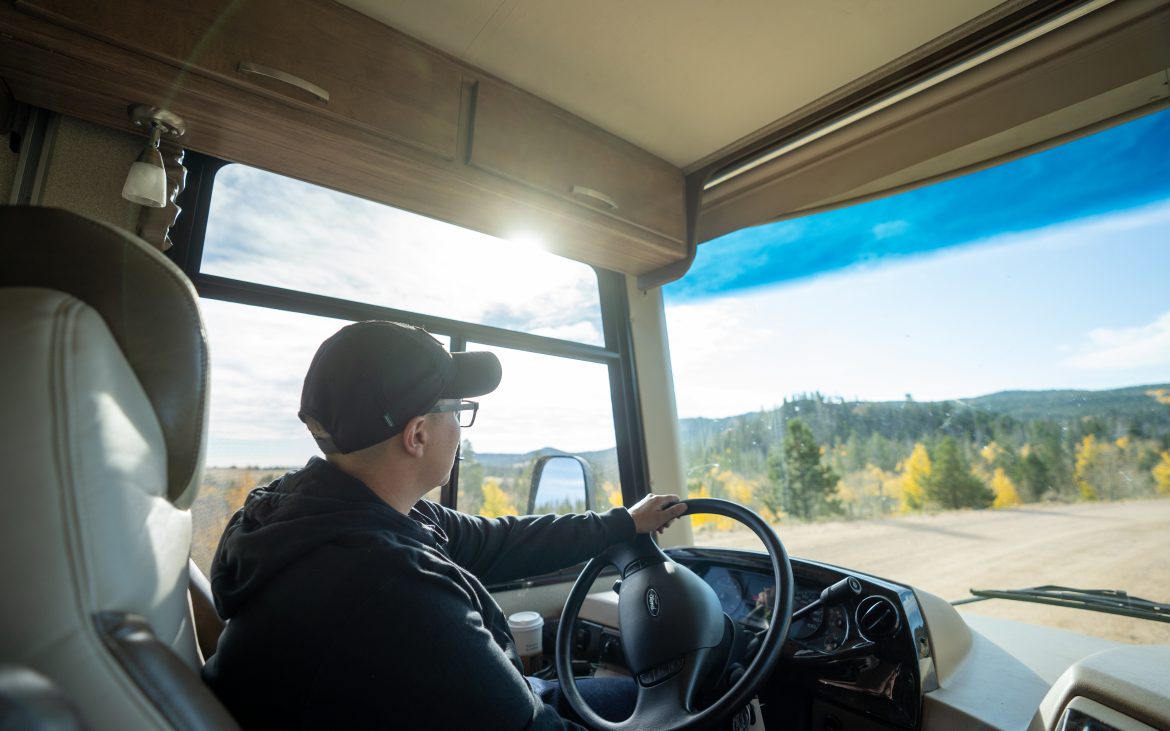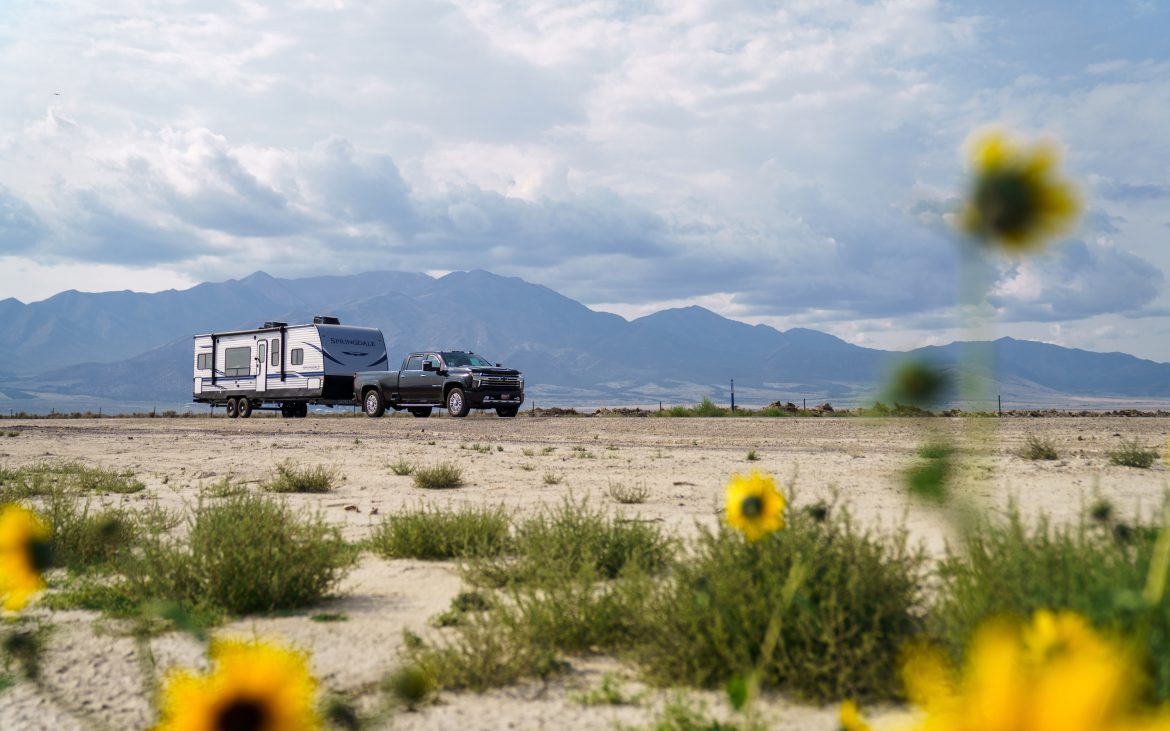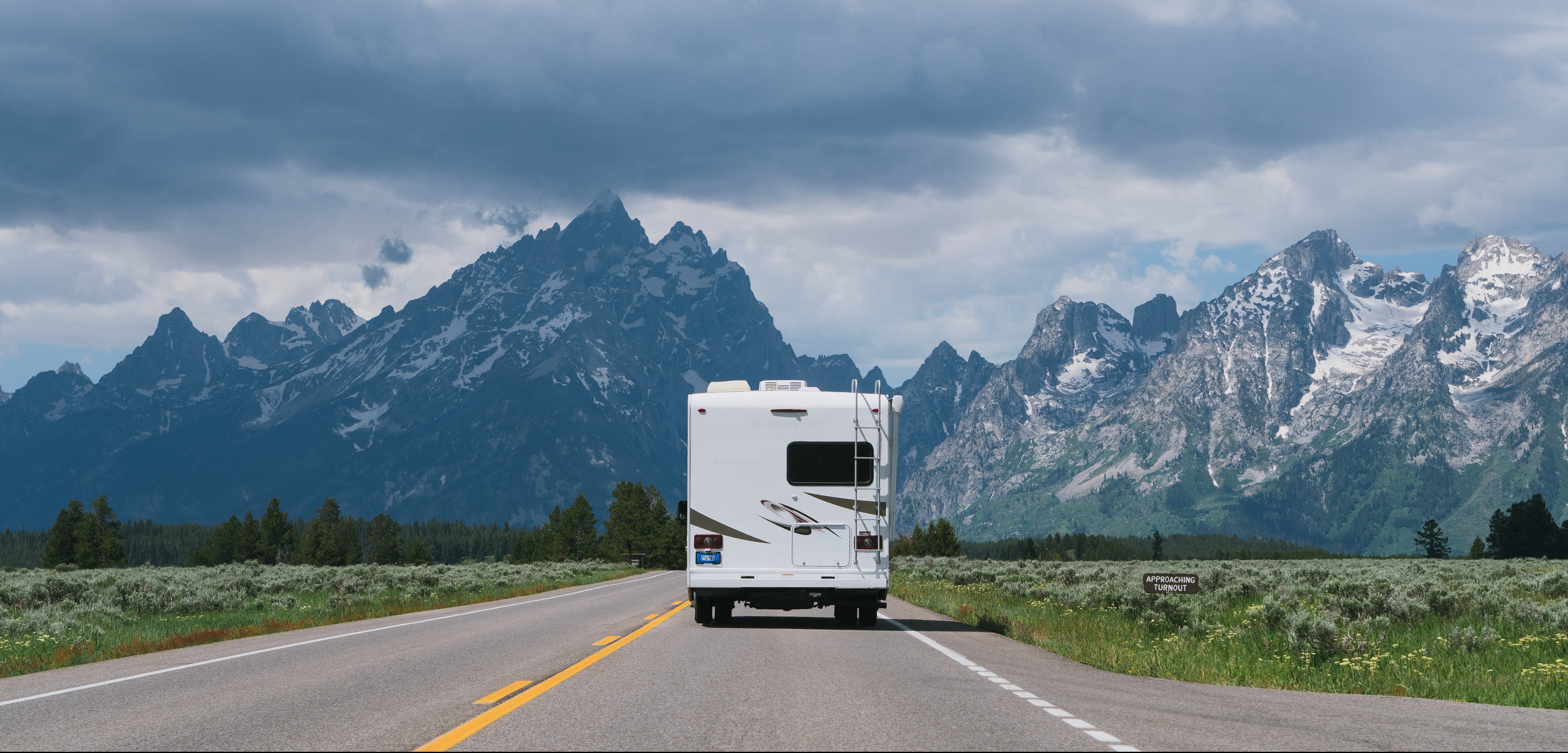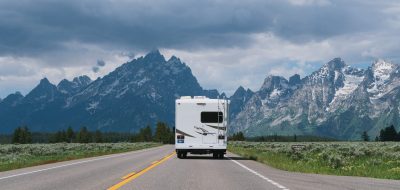Owners of motorhomes and large trailers have likely experienced the challenge of driving in high, gusty winds. Add passing semi-trucks and cars, and your trip can soon turn into what could only be described as a white-knuckle drive. Driving an RV in high winds is a formidable challenge and one you shouldn’t take lightly.
When should you not drive an RV in wind?

While unlikely, driving an RV in high winds puts your trailer or motorhome at risk of tipping. And failure to stop driving when winds get too intense can compromise your safety and those in your RV.
Not all wind or turbulence requires you to pull over. So, how much wind is too much? This depends on the rig design and specific configurations of your RV. Factors such as vehicle weight, departure angle (distance from the rear axle center to the rear bumper), weight distribution, body height, presence of steering aids, correct alignment specifications, and even tire pressure can all affect vehicle handling in high winds. Driver skill and experience also come into play when assessing a safe speed.
Generally, if you feel uncomfortable while operating in strong winds, slow down to the minimum legal speed, providing you don’t impede traffic. When wind speeds rise into the 40-50 MPH range, it’s likely a good idea to pull over, regardless of how fast you drive. If feel uncomfortable with the wind effect at the lower speed, consider stopping at the next suitable place and sit it out. Your RV is for relaxing enjoyment, not stress. Being an RV owner that is late to the next destination is far better than being the “Late RV Owner.”
Driving risks

The most common reaction during heavy gusts is the tendency to oversteer. This may actually increase the instability of your vehicle causing a dangerous situation, with or without tipping. Time and experience will help form the skills that can reduce this. But if you catch yourself frequently correcting the steering to compensate for the wind, your RV is likely already showing some signs of swaying, which is a red flag.
So let’s talk numbers, actual wind speeds. Your RV can be affected by as little as a 10 MPH breeze. At wind speeds of 15-to-20 MPH, the effect increases dramatically. Winds near 30 MPH and higher may not be safe for some RV’s to travel at highway speeds, and this is especially true if the conditions include embedded gusts.
Fortunately, sustained high gusty winds are not all that common but are more associated with short-term weather patterns, such as fronts moving through, and squalls. These are better waited out in the comfort of your RV in camp or at a rest stop where you can position your RV in an optimal location away from direct wind.
Another smart way to deal with an otherwise “white knuckle” day is to re-route your trip via a slower secondary highway or service road. Driving at speeds of 30 to 40 MPH won’t subject you to the same compounded wind effect as found on higher-speed freeways and highways. While it may take a little longer, you will probably enjoy the trip much more and even have time and focus to enjoy the sights and scenery.
So, check the weather and drive safe.






Frank Deeter
Thank you for this very informative bit of advice. As a novice at driving a vehicle this large, handling wind was a question, but not so much, now that I have a basis to use going forward.
Mike C
It have always wondered where that information about the wind speed, that I’m driving in right now, is posted. In this article, and others as well, they talk about what is happening with 10 to 20 mph or 30 to 40 mph and then 50 mph and above. More importantly, the one thing that is not mentioned, is the direction of the wind in relation to your rig. Is it blowing on your nose or coming from behind, or the very worst, is it hitting you directly on the side of your rig.
To help you to measure local wind speed, I use a simple devise that comes from sailing boats, it’s a handheld wind meter. When the wind starts to become a concern, I will stop at an appropriate turn out and measure the wind speed. This also will allow you to find the wind direction and keep that in mind as the road ahead winds from one direction to another.
Viktor
want to work with you! I have a written article
Peter Mercer
Good strategy Garth Mailman. The majority of unsettled weather occurs late in the day as temperatures rise. Thanks for your input.
John
I always check the wind for my route with an app, it helps me determine when to drive. Also, I spent a full day adjusting my WDH height over and over, and testing it over and over to get it exactly level. (Loaded) too little hitch weight promotes sway, too much hitch weight promotes bouncing on road bumps.
Jerry
I understand that parking under an overpass is often a no no. But wouldn’t that location and motorhome orientation at least protect the vehicle from the more dangerous cross winds?
Pingback: Driving a Big Rig RV? Everything You Need for Success - Cool RVers
Pingback: The Benefits of RV Skirting - Shvoong.com
Peter Mercer
Jim, You are not alone with feeling nervous about the turbulence created by some passing trucks. There are many with similar feelings. With the ideal tow vehicle and trailer set up this should be no issue. However, the jolt may still exist. Taking slower routes not only can reduce such events it can also offer a more relaxed driving experience. After all, RV travel is about enjoyment. Thanks for your comment.
Anonymous
I tow a17 ft coachman clipper –9ft tall using anti sway brake and wt. distrib bars also.when large trucks pass me my steering gets a jolt.i go about 50mph,am I forced to use smaller roads for safety?and go a lot slower?—jim
Anonymous
In regards to the maximum wind a fifth wheel trailer can endure, there is no easy answer. Much depends on the trailer profile, weight. center of gravity, stabilizer positions, etc. The best answer could probably be found by contacting the engineering department of the trailer manufacturer.
Even knowing the predicted wind speed, periotic wind gusts can exceed local weather wind speed forecasts. I hope this helps. Drive and camp safe.
Good Sam Camping
You might want to consult Florida locals who have lived through the kinds of storms you’re talking about. You can find fellow RV travelers at the Good Sam Open Roads Forum.
Anonymous
Could someone please tell me how much wind the Broadside of a Fifth Wheel can take. We have bad storms in Florida and really need to know.
Anonymous
This is a good article. I looked it up for today, April 23, 2017. This should be updated on Good Sam’s site. It is dangerous high winds today in Greybull,Wyoming. Can’t make it to Yellowstone Park! 26 mile winds
Peter Mercer
R V Lebkowsky, Yes, a headwind does not necessarily pose the same issue as a cross-wind, however, roads don’t stay straight forever. Additionally, heavy winds are often associated with approaching weather fronts. Immediate sudden wind direction changes are certain and rapid with the passing of any weather front.
Patsie Guittar
Just drove East for Cape Hatterus, NC had paid in advance, took two days from Oaklahoma. Hit a bad rain with winds and tractor trailers along with us, only one bad wind did hit us and I think we were lucky. But thanks for this info on what else we could do again.
Pingback: Follow Them 04.19.15 – Follow Us Follow Them
Carroll Lovig
We have stayed over several nights due to winds. We just don’t take the chance. My husband was blown over by wind while in a semi so he doesn’t take chances.
Susie Smeal
Thank you for an enlightening article. I just finished my first trip to the East coast and back. Some days it wasn’t worth it to travel. I use to have one rule, I would not drive in rain in my motorhome. I now have a second rule, I will not drive in windy conditions, not worth it.
Dave Jones
I relate it to carrying a sheet of plywood when it is windy.
Garth Mailman
I try to do my driving early in the day. Winds don’t usually pick up until later in the afternoon. If high winds persist overnight or heavy weather is predicted it’s a sign that the prudent RVer should spend an extra day in Camp.
R V Lebkowsky
Good article, except no mention of crosswind component (wind direction relative to direction of travel). A high crosswind component (at high angles to direction of travel) is more important than wind velocity.15 – 20 MPH of direct crosswind is more dangerous than 50 MPH on the nose or tail. A large Class A machine is a real handful in a high velocity crosswind.